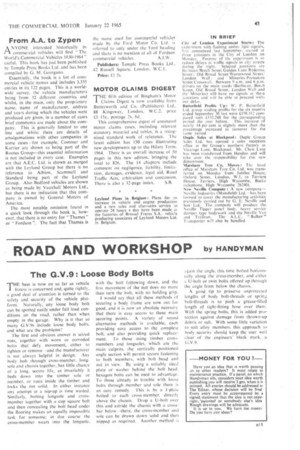ROAD AND WORKSHOP by HANDYMAN
Page 45

If you've noticed an error in this article please click here to report it so we can fix it.
The G.V.9 : Loose Body Bolts
THE heat is now on so far as vehicle fitness is concerned and, quite rightly, a good deal of attention is turned to the safety and security of the vehicle platform. Naturally, any loose body bolt can be spotted easily under full load conditions on the road, rather than when empty in the garage. Why is it that so many G.V.9s include loose body bolts, and what are the problems?
'The first and obvious answer is seized nuts, together with worn or corroded bolts that defy movement, either to tighten or remove—and the manufacturer is not always helpful in design. Any body bolt through cross-member, longsole and chassis together, has little chance of a long, secure life, as invariably it beds down into the timber sole or member. or rusts' inside the timber and locks the nut solid. In either instance any attempt at a nip-up is time wasted. Similarly, bolting longsole and crossmember together with a cup square bolt and then concealing the bolt head under the flooring makes an equally impossible task for someone; in due course the cross-member wears into the lonesole. with the bolt following down, and the first movement of the nut does no more than turn the bolt, with no holding grip.
I would say that all these methods of securing a body frame are now out for good, and it is now an absolute necessity that there is easy access to these main securing points. A variety of sound alternative methods is available, each providing easy access to the complete bolt, and also providing quick replacement. To those using timber crossmembers and longsoles. which are the main culprits, the vertically positioned angle section will permit secure fastening to both members, with bolt head and nut in view. By using a suitably sized plate or washer behind the bolt head. hexagon bolts can be used to advantage. To those already in' trouble with loose bolts through member and sole there is an easy remedy. This is by a J-plate bolted to each cross-member, directly above the chassis. Drop a U-bolt over this and astride the chassis with a crossbar below—there, the cross-member and sole can be drawn down solid and then nipped as required. Another method is
again the angle, this time bolted horizontally along the cross-member, and either a U-bolt or twin bolts offered up through the angle from below the chassis.
A good tip to preserve unprotected lengths of body bolt-threads or spring bolt-threads is to push a grease-filled length of tight-fitting hose over them. With the spring bolts, this is added prosection against damage from thrown-up debris or salt. With some little variation to suit alloy members, this approach to body security should keep the user well clear of the eneineers' black mark, a




















































































































